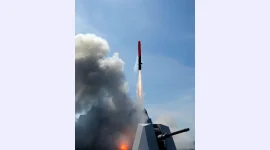- Views: 2K
- Replies: 6

Rumors have swirled for years about a secret Indian superweapon called "Kali-5000," said to be capable of destroying satellites and missiles with powerful energy beams. However, much of what's circulated online about this alleged project is steeped in misinformation. Let's separate fact from fiction and uncover the truth about "Kali-5000."
KALI: A Scientific Endeavor, Not a Superweapon
"KALI" (Kilo Ampere Linear Injector) is not a weapon at all. It's a scientific research project initiated by the Bhabha Atomic Research Centre (BARC) and later supported by the Defence Research and Development Organisation (DRDO). KALI focuses on studying high-power electron beams and plasma research, with potential applications in areas like materials science and diagnostics.Debunking the Myths
- Myth #1: "Kali-5000" Can Disable Enemy Satellites: While KALI generates high-energy electron beams, its capabilities are limited to laboratory settings. Disabling satellites would require overcoming immense technical hurdles related to distance, precision, and environmental interference—challenges far beyond KALI's current capabilities.
- Myth #2: "Kali-5000" is an Anti-Missile or Directed-Energy Weapon: Although DRDO is involved in developing directed-energy weapons, KALI is not one of them. It lacks the tracking, targeting, and intercepting mechanisms essential for weaponization.
- Myth #3: "Kali-5000" is a Classified Superweapon: While certain aspects of KALI may be subject to security protocols, much of the research has been published in scientific and defense forums. Its primary purpose remains scientific.
What KALI Actually Does
KALI's primary function is to research high-energy electron beams and plasma physics. It has potential applications in:- Scientific research: Advancing knowledge in particle physics and beam technology.
- High-energy electron beams: Used in research and scientific applications.
- Electronic warfare research: Potentially disrupting electronics at close range, but far from being a weaponized system for offensive operations.
DRDO's Real Defence Advancements
DRDO is indeed developing advanced defense technologies, including missile systems, electronic warfare capabilities, and directed-energy weapons. India's missile defense program includes projects like the Ballistic Missile Defense (BMD) shield and the Anti-Satellite (ASAT) system.DRDO has also made progress in developing solid-state lasers and microwave-based systems for defense against drones and other aerial threats. These are real, deployable technologies, unlike the experimental KALI project.
The "Kali-5000" superweapon is largely a product of online speculation. While India is actively pursuing advanced defense technologies, KALI itself is a scientific research project with limited defense applications. Its true contributions lie in advancing scientific knowledge, not developing destructive weaponry.



